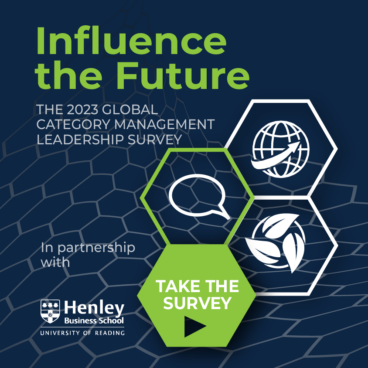
Podcast
Embedding Category Management And The Future | Jon Hughes
In episode 3 of our 5-part podcast series on category management in procurement, Jon Hughes and Mark Webb talk about the value streams available by engaging with suppliers
By Mark Webb |

Jon Hughes
Profile
35 years international business experience specialising in procurement change management.
Previous employment:
General Motors, British Steel, NWRMC, Co-Founder & Chairman of ADR Purchasing Consultants, Innovation Director for QP Group.
Education:
BA (Hons) and MA in Organisational Psychology, Cambridge University.
CIPS Fellow and holder of their Swinbank Award for Procurement Innovation.
Former Visiting Fellow at Birmingham University and the Vlerick Leuven Business School.
Role in FP: Chairman
Mark Webb, Managing Director, talks to Jon Hughes
In episode 3 of our 5-part podcast series on category management in procurement, Jon Hughes and Mark Webb talk about the value streams available by engaging with suppliers
Transcript
00:00:00:01 – 00:00:29:29
Mark Webb
Did you get any clients? Because it just reminded me of a current situation where setting up the governance involved something across the top, really working with the procurement leader. Where, you’ve got business leaders involved in some sort of governance structure that’s overseeing the implementation of this. So there’s basically organizational skill in the game from the start as opposed to leaving it, you know, for the CPO to work with their boss directly, but having something broader, which is that sort of collective governance across the program?
00:00:30:00 – 00:00:52:06
Jon Hughes
Well, I think it is, and without any doubt at all, we’re into KPIs, all the various performance indicators and most importantly the linking with executive remuneration. I think one of the huge step changes is when any part of the organization is measured on what it’s achieving in terms of critical objectives, one of which is procurement and which goes through into executive compensation.
00:00:52:07 – 00:01:22:18
Jon Hughes
Going back to right at the start of the whole piece with Reckitt and Colman the chief executive at the time, John West. He’d been a military policeman out in Asia dealing with extremely violent situations in the sixties and he was a tough guy. Seriously tough guy.
I remember we did a presentation at his Chief Executive Officer conference and he stood up and he just said to the community, “This chief executive’s conference is going to make the decision as to whether or not we do a global procurement initiative.” And he made that statement and all the managers around the room listened to it. And he then said, “At the end of this discussion, those of you who don’t want to support this procurement initiative, I’d like you to stand up.” Not many people stood up, Mark. Now, that is actually the antithesis of executive engagement. But what he then said was, “Okay, every person in this room is now backing this initiative.”
“I’m going to ask our central audit team to track this with every business worldwide. I want to know what the delivery is from every single business. The audit team will be doing this. I’m not going to ask procurement to do it. I’ll ask the audit team to devise a way of building this in as a performance metric for the business in every operation worldwide.” Now, that is tough management.
00:02:09:07 – 00:02:31:19
Jon Hughes
I’m not saying I won’t put it out because that’s what you’ve got to do necessarily. It was hardwired into performance measurement; there would be performance tracking; there would be challenge. Those people who were delivering a lot would get additional compensation. Those people who were the laggards, they would not just be allowed to ignore it and avoid doing it.
Again, another chief executive I worked with in the early days of Diageo was a great believer. He said to me: “What you have to do as a chief executive is have a light grip on the throat of all your senior management.” And his view was that we don’t have any grip on any throats in procurement, so we don’t know whether we’re doing it or not doing it.
00:02:50:12 – 00:03:11:25
Jon Hughes
We don’t know whether it’s being supported or whether it’s being resisted. So it’s back to a point you made earlier. We have the soft side, but we’ve also got the hard side. And we’ve got to link the two together. We’re saying if it’s worth doing, we’ve got to do it well and then we’ve got to recognize that there will be some people who won’t do it well, also be some people who will be complete enthusiasts for this, and we want this.
00:03:11:25 – 00:03:16:12
Jon Hughes
People who are succeeding. We want that made visible and we want people to give them the credit for it.
00:03:16:12 – 00:03:27:18
Mark Webb
Absolutely. And just going back to a comment you made earlier, how long would you see in your experience, those early days, how long did it take to embed as a sort of institutional way of working?
00:03:27:19 – 00:03:46:21
Jon Hughes
I think if we go back to the initial assignments that we did, I can’t think of any assignment with less than three years. So, we worked for an extensive period of time. And interestingly, I remember putting in some of the initial proposals on the length of time, how long we thought it would take to get it to the stage where it would be self-sustaining.
00:03:46:21 – 00:04:11:27
Jon Hughes
We had a concern that the clients wouldn’t pay for it. You know, if we went there and said, “Look, we need a three year assignment. It’s going to cost this amount of money.” They would say, you know, “You’re kidding. I mean, what is procurement? It’s only negotiation. I mean, why would it take three years to get to that stage?” And again, I remember one client, we did this presentation and we were nervous about it because there was this three year time horizon and the person said the only reason why I’m going to back you is that you are telling me it is going to take three years.
00:04:11:27 – 00:04:29:11
Jon Hughes
If you’d come in here and said you can get this done in six months, I’d have thrown you out. He said anything that’s really important and it’s really worth doing, it is going to take time. Now putting some sort of flesh on the bones of that, if you go to any organization and you say, okay, how many people are there who are working in procurement that will give you a figure.
00:04:29:11 – 00:04:50:07
Jon Hughes
You then say, okay, so how many people not working at a procurement function are dealing with suppliers? That will give you another figure. You know how many people are there who are not directly interfacing with suppliers but are in some way connected to supply operations, gives you another figure. It doesn’t take long before you come up with hundreds, if not thousands of people.
00:04:50:18 – 00:05:11:07
Jon Hughes
Now, you know, a lot of what we talked about so far, of course, is focused on manufacturing, but if we move into the public sector, whether it’s the health service or government, local government, the numbers there are extraordinary, aren’t they? I remember you and I did a presentation a few years ago in number ten to a strategy adviser to the Prime Minister on the National Health Service.
00:05:11:07 – 00:05:45:13
Jon Hughes
And I think the third-party expenditure was something in the region of about 90 billion. And the numbers of people involved in procurement in the NHS, you know, is like tens of thousands of people.
Similarly in national government, all the changes have taken place over the years trying to deal with category management in government. So the whole change management piece is clearly tied in with the total cohort of people who are influencing and managing procurement and suppliers, and then through them the number of senior managers who are really the gatekeepers for the whole exercise.
00:05:45:13 – 00:06:14:11
Jon Hughes
Anyone who doesn’t get their mind around that in a fairly systematic way will fail. And again, in all the work we’ve done on stakeholder management and constituency mapping over the years, that’s really what gives you the major challenge, isn’t it? You’ve got to get to that critical mass of people and move them from being, maybe, openly hostile, through being quite cynical, being negative, being neutral, to being open, to being convinced, to being positive, to being enthusiastic.
00:06:14:11 – 00:06:23:23
Jon Hughes
When you start any initiative, the distribution is down one scale and you’ve got to move that distribution to the other scale. That remains a big challenge.
00:06:23:23 – 00:06:42:28
Mark Webb
That’s the multiyear piece and trying to take the team and replace people who don’t really fit into that sort of cultural approach, which is much more collaborative with stakeholders and seeing their role as much more empowered. Again, in the early days, did you see a lot of people that felt that sort of empowerment to drive change or would they say, actually, you know, I get given the specification and my job is to negotiate and to place the contract. Was that sort of view prevalent at the time?
00:06:51:08 – 00:07:12:15
Jon Hughes
There were two views. I think one view was a lot of procurement people just saw themselves in a transactional role. My job is order placing, matching of P.O.s against invoices, paying on time. That’s it. And didn’t really want to go much beyond that. They saw procurement in very sort of transactional terms. I think there was a second group who saw themselves as serving the factory, in some way.
00:07:12:17 – 00:07:37:15
Jon Hughes
So the whole specification piece, you know, nailing down suppliers, dealing with poor supply, quality management issues, all the rest of it. I think you had a third but much, much smaller group, who I think were taking a sort of total value management perspective saying, look, you know, we’ve got all sorts of business requirements here, with all sorts of business needs and we’re being one eyed, we’re only really focusing on one or two things. What we need to do is to have a much broader palette of factors and dimensions that we’re concentrating on and then unlocking that value.
Now, again, the distribution in procurements, in those early days, there were not that many people arguing that we should be taking that much broader perspective on value delivery.
00:07:55:24 – 00:08:19:15
Mark Webb
That whole business requirements piece, is still surprising in many organizations, that it’s not at the heart of what they’re doing and being able to demonstrate to stakeholders that it’s more than just costs that we’re actually interested in. We are interested in assurance of supply and we are interested in innovation. Was that a tool that you introduced during the early days or did that tool come later on?
00:08:19:20 – 00:08:42:27
Jon Hughes
It came later on in the early days. That would have been just a step too far. Again, I think in the early days we have to recognize that the majority of people tended to define procurement in terms of financial deliverables, particularly cost containment and cost reduction. And back to prioritization, we had to deliver significant financial benefits that went through the audit process and was signed off and were deemed to be genuine cost savings.
Yeah, if we’d gone beyond that too soon, that would have just completely eroded what we tried to achieve. However, once we’ve been through that first wave and we demonstrated that there were very significant financial deliverables, the second wave then opened up, and the third wave opened up, and the fourth wave opened up.
Now, again a nice example of that, I did a piece of work for Carlsberg, the brewers and the chief executive had come in from a major packaging organization and he’d actually been a supplier to Carlsberg. So he was a sort of poacher turned gamekeeper and he would say, well, we don’t really do anything with suppliers. We do the sourcing, we get our head around you know, bottles and packaging but we’re not doing anything proactive with our suppliers. We don’t have any supplier management.
So I said well why don’t we organize a supplier conference? We got 50 of Carlsberg’s suppliers into their beautiful headquarters in Copenhagen and said what we’ll do is we’ll do a classic brainstorming event and then we’ll have a dinner in the evening.
And they actually made a dinner based around beautiful Carlsberg beer. They made some special beer for the event. So the key thing was we did a whole series of workshops and rather than procurement, telling the suppliers, we got the suppliers to tell procurement and the business. We did a whole series of brainstorming events on value that could be captured that was not in any shape or form flowing into Carlsberg from the suppliers.
We did a series of events. We captured it, we systematized it, did all the affinity analysis, and we ended up with over 75 value streams that were there, that were not in any shape or form built into the procurement culture. Now, I’ve always been a huge proponent that suppliers are the best free management consultancy resource you don’t harness. So that was good.
But I did another one, this was actually triggered by a piece of work with it with a marketing community. And I said, Well, would you mind if I went round with a video camera to a couple of major advertising agencies and asked them to tell me how they saw your organization. They said oh feel free.
Off we went and I went and interviewed people at Ogilvy and Mather, people like that, about the way in which the marketing community were working with them and they said, Well, it’s ridiculous. It’s absolutely ridiculous. They tell us what they want. They don’t ask us what we could provide, very basic stuff.
But then they said they also they tend to come along to us with amazing specifications of what must be created. And we deliver against those specifications. And then when we come to do the sort of media presentations to them, some of them will then stand up and say, Oh, I don’t like this, I don’t like X, I don’t like Y.
So Ogilvy and Mather ended up producing five or six different media options that were created for the client because they knew they’d reject most of them. So basically, the bill was sixfold higher than it should be because there was no proper dialogue at the very early stage as to how this whole media advertising exercise ought to evolve. Why? Because the client and O&M didn’t sit down and co-develop or co-evolve the campaign.
Typical examples here, I think of the supply base just looking in and saying, okay, we’ll work in any way that you like, in any way that you tell us, but it could be that you’re leaving a profound amount of value on the table.
00:11:57:22 – 00:12:21:02
Jon Hughes
In the final example, go back to the automotive assemblers up in Nissan. When Nissan first came into the UK and introduced the revolutionary concepts of single sourcing, I had contact with someone who worked at a very senior level at Nissan. They went out and talked to suppliers and asked them what target margins they wanted to achieve. And the suppliers were completely unused to anybody asking about that and they said, well I don’t know, 15%? okay, agreed. Agreed? 15% margins!
Yeah, the question now is how are we going to deliver that target margin for you, because we also have a target margin. So to move from bottom up to top down to say, right, target margin for our business is X, therefore target cost has got to be Y, then you’re coming down with a completely different mindset, that was just revolutionary. So back into these waves. You start off at maybe the more tactical end of the cost management scale before moving up into the more strategic end of the scale.
Further listening
Podcast episode one: Rethinking Procurement in 2023
Podcast episode two: Re-Organising Procurement using category management

About Mark Webb
Managing Director
22 years procurement experience in line management
and consulting roles.
Previous employment: Price Waterhouse, Mobil Oil and QP Group
Education: BSc in Management Science and MSc in Business by Research, Aston University
CIPS: member

